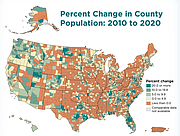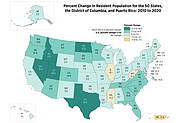Census confirmation: Our county is booming
Data from the 2020 U.S. Census Bureau shows what Idahoans already know — the Gem State and Kootenai County are growing.
And fast.
Per the census, the Kootenai County population as of April 1, 2020, was 171,362 — a 23.7% and 32,868-resident increase from 2010.
In 2016, the Kootenai Metropolitan Planning Organization projected that Kootenai County would be home to 166,690 in 2020.
"KMPO was often told we were way optimistic," Executive Director Glenn Miles said.
Miles said the organization suspected the 2020 data "had probably surpassed our forecasts" due to the number of building permits within the county.
"We had heard rumors last spring the number would exceed 170,000 population, so it wasn't too much of a surprise," he said. "Growth is occurring everywhere."
Kootenai County is the third-largest and third-fastest growing county in Idaho, according to the census. Miles said the data, released last week, "put the forecasts on track" to meet the KMPO projection for over 300,000 Kootenai County residents by 2040.
Typically, Kootenai County experiences a 2 to 3.5% growth rate year over year, Community Development Director David Callahan said. The census data is on par with expectations when factoring in cities like Post Falls, which Callahan said has reported a 9.5% growth rate.
Building permits "can certainly attest" to the magnitude of growth, Callahan noted. He said the Kootenai County Community Development Department has seen 45% more building permits in 2021 than in 2020.
According to a presentation shared by the director, his department reported about 1,620 building permit applications had been submitted this time last year. So far in 2021, 2,314 applications have come in.
"That is an extraordinary thing in my business," he said.
Every decade, the U.S. Census Bureau releases a report summarizing demographic information for counties and states that measures changes in population, race and housing status. The data is used to determine several items, including congressional apportionment, Electoral College representation, redistricting and other public and private decisions.
The 2020 data will also influence how over $1.5 trillion in federal funding will be allocated to transportation projects, school districts, hospitals and other local jurisdictions.
Miles said the Idaho Transportation Department has focused recent investment projects predominantly in Ada and Canyon counties. While those projects don't directly affect North Idaho drivers, Miles said those efforts were needed to support substantial growth in the areas — which, according to the census, are the two most populated counties in the state.
However, in response to the growth of Kootenai County, Miles said ITD has started to look north.
"It's nice to see ITD now moving forward with similar major investments in our area, which have waited its turn to address what are now similar growth challenges," Miles said.
Miles pointed out that if Kootenai County's new growth population — 32,868 — were isolated into a separate division, it would be larger than 33 Idaho counties. It would also be bigger than 153 existing Idaho cities, he said.
"It would be larger than Moscow and just slightly larger than Lewiston," he said.
Between 2010 and 2020, the Ada County resident population increased by 102,602 (26.1%) to 494,967, according to the census. Canyon County grew by 42,182 (22.3%), to 231,105 as of April 1, 2020.
"Ada, Canyon, and Kootenai County represent just under 50% of the population of Idaho," Miles said.
All indicators show that continued growth in Kootenai County is "inevitable into the foreseeable future," Miles said.
Tackling growth-related issues like transportation, affordable housing, character preservation, community collaboration and family-wage jobs will be key, in Miles' mind, to defining "how well we adapt to our new reality."
"Kootenai County and the Inland Northwest has been found to be a very attractive place to live by people from throughout the U.S.," Miles said. "I hope we are, as a region, able to recognize we've been found and are further able to manage that reality."
According to the census, about 1.8 million people now call Idaho home — up from 1.5 million in 2010. Percentage-wise, the 17.3% population change puts Idaho as the second-fastest growing state in the nation, trailing only Utah.
Utah grew by 18.4% and approximately 507,000 "new" residents.
Since the 1910 U.S. census, Idaho's population has increased by about 465% from a mere 325,594. The Gem State has seen a steady rise in residents over the last century, running from 3% to 33% every decade.
Idaho data is quite the opposite of the national population growth rate, which census officials said last week has slowed since the 1950s. According to the census, the U.S. population grew by just 7.4% from 2010, the slowest rate since the 1930s, to 331.4 million in 2020.
Callahan said the county growth rate outpaced both state and national levels for decades. Specifically, between 1969 and 2018, Callahan said, Kootenai County's overall population grew by 340.8%. The state, by comparison, increased by 131.1% and the U.S. by 60.5% in the same period.
"Our line is almost logarithmic compared to the straight line the state and nation have seen," Callahan said. "We've been experiencing growth for a long time."
There were 74,736 housing units in Kootenai County at the time of U.S. census data collection — an 18.3% (11,559) increase from 2010. Still, the census found that Kootenai County's housing unit vacancy rate is about 10% — compared to Canyon County's 3.9%, the lowest in the state.
The University of Idaho is developing a housing study to assess Kootenai and Shoshone county markets, Panhandle Affordable Housing Availability spokeswoman Maggie Lyons said.
"We have an inadequate supply of affordable housing in Kootenai County due to the growth and other issues like problems with construction, supply chain and costs," Lyons explained.
Though study data is unfinished, Lyons said the census's 10% vacancy rate seems too high, particularly for apartments and low- and middle-income properties. A final copy of the study is expected to be published by Oct. 31.
"I would suggest the vacancy rate is lower based on what we are seeing," Lyons said. "At PAHA, we've had zero vacancies the entire time I've been involved."
Census officials noted that the data is not perfect. In a statement last week, officials said the information gathering process has changed since 2010, and workers were significantly challenged by the COVID-19 pandemic, which could have impacted data.
Census data regarding city populations are still estimates, Post Falls Community Development Director Bob Seale said. He explained that the final data set that breaks down city population, housing and other measures should be released sometime in September.
Still, Seale said the city is anticipating that the data should align with their projections.
"We're looking forward to seeing what the actual data says and how close our estimates are," he said.





